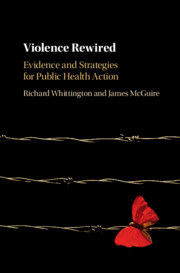Book contents
- Violence Rewired
- Violence Rewired
- Copyright page
- Epigraph
- Contents
- Figures
- Tables
- Boxes
- Foreword
- Acknowledgements
- Introduction and Overview
- Part I Origins
- Part II Solutions
- 6 Advancing a Global Public Health Response to Violence
- 7 Risk Assessment
- 8 Pharmaceutical Interventions
- 9 Psychosocial Interventions
- 10 Changing Structures
- Rewiring Our Expectations
- Appendix Major UN Initiatives to Address Violence, 1986–2018
- References
- Index
10 - Changing Structures
Integrated Interventions for Violence
from Part II - Solutions
Published online by Cambridge University Press: 13 March 2020
- Violence Rewired
- Violence Rewired
- Copyright page
- Epigraph
- Contents
- Figures
- Tables
- Boxes
- Foreword
- Acknowledgements
- Introduction and Overview
- Part I Origins
- Part II Solutions
- 6 Advancing a Global Public Health Response to Violence
- 7 Risk Assessment
- 8 Pharmaceutical Interventions
- 9 Psychosocial Interventions
- 10 Changing Structures
- Rewiring Our Expectations
- Appendix Major UN Initiatives to Address Violence, 1986–2018
- References
- Index
Summary
The comprehensive biopsychosocial approach to violence requires and enables us to ensure the role of social structures is incorporated in explanations of violence and approaches to addressing the problem. Tackling these social formations requires a public health approach which combines many of the interventions we have considered so far but in addition is designed to do so in an integrated programme which coordinates interventions at different levels. There has been significant growth in these integrated interventions over the past twenty years, especially with vulnerable groups in low- and middle-income countries, and we will consider some examples in this chapter. They are integrated in the sense that they often consist of ‘bundles’ of discrete intervention packages (Yount et al., 2017) operating at distinct levels within and between individuals and across whole societies to tackle violent behaviour both directly and indirectly. These programmes often combine primary prevention through broad structural changes with more direct and focussed interventions with high-risk groups. They may aim, for instance, to equip vulnerable women with the skills necessary to assertively set limits when they are exposed to violent behaviour by their partner. At the same time, they may aim to enhance the status of the same women through providing economic resources which empower them more generally in their relationships with men. The same programmes may also be designed to work with the perpetrators to change both their approach to negotiating with their partner in conflict situations and to change their attitudes toward women more generally. So these integrated programmes operate both on violence itself directly and, for example, on gender relations as an indirect factor associated with premature death from violence and from other avoidable causes such as HIV/AIDS.
Information
- Type
- Chapter
- Information
- Violence RewiredEvidence and Strategies for Public Health Action, pp. 225 - 241Publisher: Cambridge University PressPrint publication year: 2020
